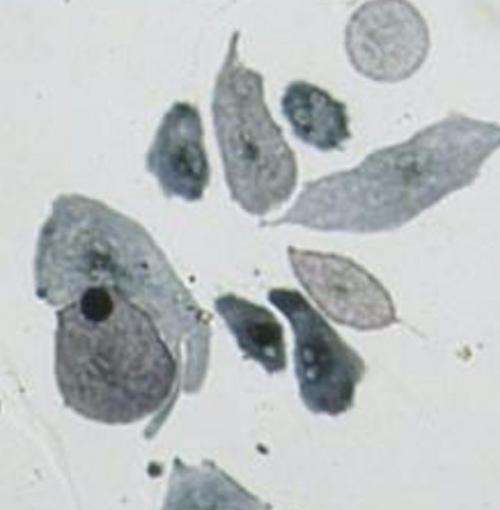January 21, 2014 report
Study of zebrafish skin patterns shows cells chasing other cells around (w/ video)

(Phys.org) —A team of researchers at Osaka University in Japan has discovered that one type of zebrafish pigment cell chases another around in a Petri dish possibly explaining how they fish gets its stripes. The team has published its findings in Proceedings of the National Academy of Sciences.
Zebrafish, unsurprisingly, have striped bodies, reminiscent of zebras. But how does its biology decide to create the stripped patterns, and how does it make it come about? Research by the team in Japan, may be about to provide an answer.
Scientists have wondered about how animals get their stripes or spots for years. Are they hard-coded in DNA, the same way that an organism is able to produce an arm or leg, or is there some other mechanism at work? Oddly, Alan Turing, the famous math and computer visionary asked himself this very question back in the 1950's, and it turns out his theory may turn out to be closer than anyone expected. He came up with a mathematical model that described the interactions between two molecules—one that causes a pattern to appear and one that attempts to stop it. In this new research, it's not molecules, but whole cells that appear to be doing something similar.
To find out what's going on with the zebrafish's stripes, the researchers placed a single yellow pigment cell (xanthophore) in a Petri dish and watched it wander around aimlessly. They did the same with a black pigment cell (melanophore) and found it behaved in much the same way. But when they placed both in a Petri dish, they discovered the yellow cell (using finger-like projections) actually chased the black cell around. They noted the black cells were able to move slightly faster, which meant there was a constant game of near catch and run.
The researchers can't prove it, at least not yet, but they suspect the game of catch and run exhibited by the two cells is what results in the stripes seen on a whole fish. If there were hundreds, or thousands of such cells all playing catch and run with each other, they suggest, it's possible that the end result would be a corralling of the black cells, resulting in a shape that to us looks like long black stripes.
More information: "In vitro analysis suggests that difference in cell movement during direct interaction can generate various pigment patterns in vivo," by Hiroaki Yamanaka and Shigeru Kondo. www.pnas.org/cgi/doi/10.1073/pnas.1315416111
Journal information: Proceedings of the National Academy of Sciences
© 2014 Phys.org
















